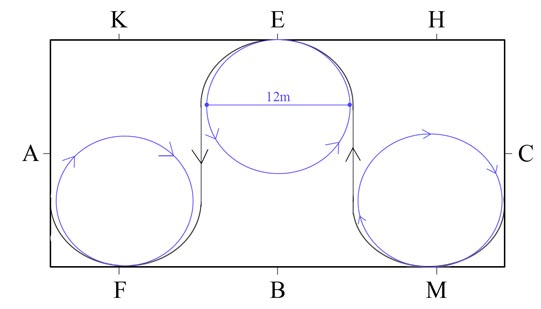Lesson Plan 6 – Improving lateral bend with serpentines.
The horse needs to be supple both longitudinally (over the topline) and laterally (through the sides). In my opinion riders do not achieve the correct level of lateral suppleness that is required for proper work to be achieved. For example most riders, when attemtping shoulder-in, are actually showing a leg yield because there is very little, if any, lateral bend and suppleness. This schooling plan is one of many that can be used to improve lateral suppleness / bending.
Key Benefits: Improves arena awareness and accuracy of patterns; improves rider efficiency in changing over of the aids; improves suppleness in the horse.
Schooling plan:
1. Walk stretch, big walk and really draping him down whilst actively stepping forwards. Then have a period of
stretching the horse down in trot. Looking for looseness, relaxation and stretch with active forward steps.
{Options: include canter stretch depending on level and balance of horse}
2. After a walk break, pick up the contact and ride an active forward working trot. Checking your position and aiding and look for the reaction to your forward driving aids, the seeking of the horse through the body to the contact and the soft acceptance of the bit.
3. Ride a 3 loop serpentine in the rising trot. Ride this with good activity, changes of bend and accuracy. On one loop the inside hind leg is carrying weight and the outside hind leg has further to travel. Through the change of rein the roles of each hindleg have to change so it is important to remember not to ride "backwards" through the change of rein but to ride forwards through the change of bend through to the next loop.
Make sure to change the rein and check the ability to ride the exercise with the same flow and accuracy starting off either rein.
4. After a couple of repititions in either direction have a trot stretch then a walk break.
5. Now repeat the 3 loop serpentine adding a circle in the top of each loop.

As you can see the 40m school will split into three segments, allowing for you to ride a 12m circle in the top of each loop. This is a good suppling exercise as well as increasing the working of each hindleg through the circle work. You can count the strides through the circles to check for evenness, roundness, rhythm and equality in both directions. Remembering that the whole point to lateral bend is to start the process of working each hindleg equally and as such the arena patterns and movements should be looked at with assessment in both directions.
Have another trot stretch and walk break.
6. Then repeat the wole theme but this time on a 4 loop serpentine with circles in the top of each loop, which now makes the circle 10m diameter. Pay attention to the activity forwards, the reach through the body to the contact, the evenness of the bend in either direction and the flow through the changes of rein.
7. Transitions can then be added over the centre line. The smaller circles can greatly aid with the preparation for a downwards transition. Start by riding trot – walk – trot over each centre line and then progress to trot – halt – trot. Make sure that you are straight over the centre line in order to achieve a good, square collected halt.
As an addition to 4 loop version, depending on level and stage of horse you can add shoulder-in on each long side after the arena pattern. A 4 loop serpentine changes the rein each time so after each repitition you will riding alternate shoulder-in's.
This exercise can then be developed with the work in the canter. Riding the 3 loop serpentine in the canter first with canter – trot – canter transitions over the centre line is a good gymnastic exercise in itself. Then add the circles to increase bend and collection to the canter. When these are coming along well ride simple changes across the centre line with one horses length of walk in between the canters. This could be used later for work with the flying changes.
Each schooling session should gradually build the work load through the session with stretches and breaks inbetween. Then always finish with a good warm down period and only increase the work load to the level of fitness and stage of training for the individual horse.
